International Tourism & Hospitality: Analyzing Uluru's Transformation
VerifiedAdded on 2022/07/28
|12
|2491
|45
Report
AI Summary
This report examines the impacts of tourism on Uluru, focusing on the physical, social, cultural, and economic dimensions. It highlights the events leading to the closure of climbing Uluru, driven by the traditional owners' concerns and the environmental degradation caused by irresponsible tourist behavior. The study delves into the political and social factors influencing this decision, emphasizing the need for sustainable tourism practices. It also explores the role of Destination Management Organizations (DMOs) in promoting responsible tourism through strategies like ecotourism, cultural awareness, and community involvement. The report concludes by stressing the importance of balancing economic benefits with the preservation of cultural heritage and environmental sustainability, advocating for a shift towards responsible tourism practices.
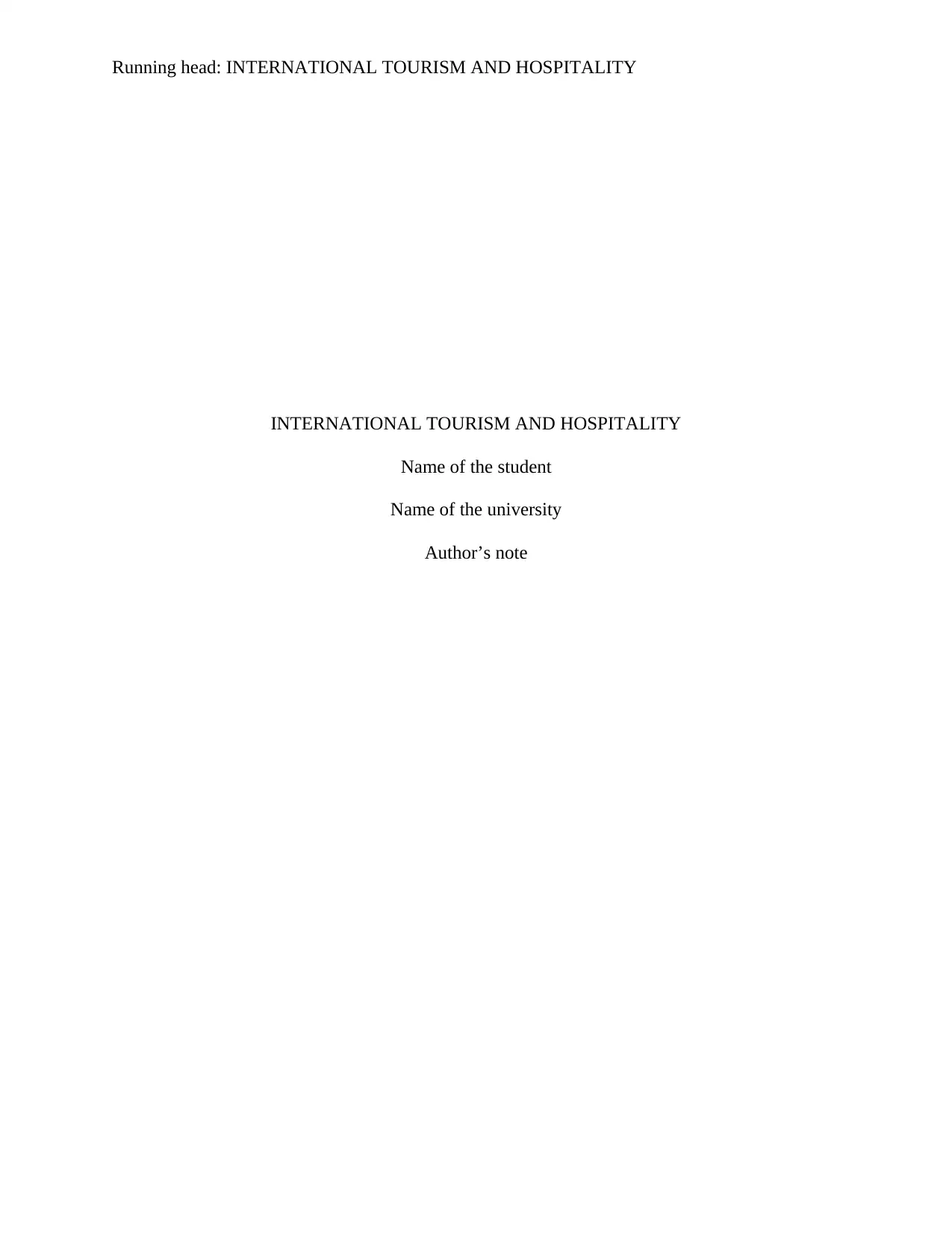
Running head: INTERNATIONAL TOURISM AND HOSPITALITY
INTERNATIONAL TOURISM AND HOSPITALITY
Name of the student
Name of the university
Author’s note
INTERNATIONAL TOURISM AND HOSPITALITY
Name of the student
Name of the university
Author’s note
Paraphrase This Document
Need a fresh take? Get an instant paraphrase of this document with our AI Paraphraser
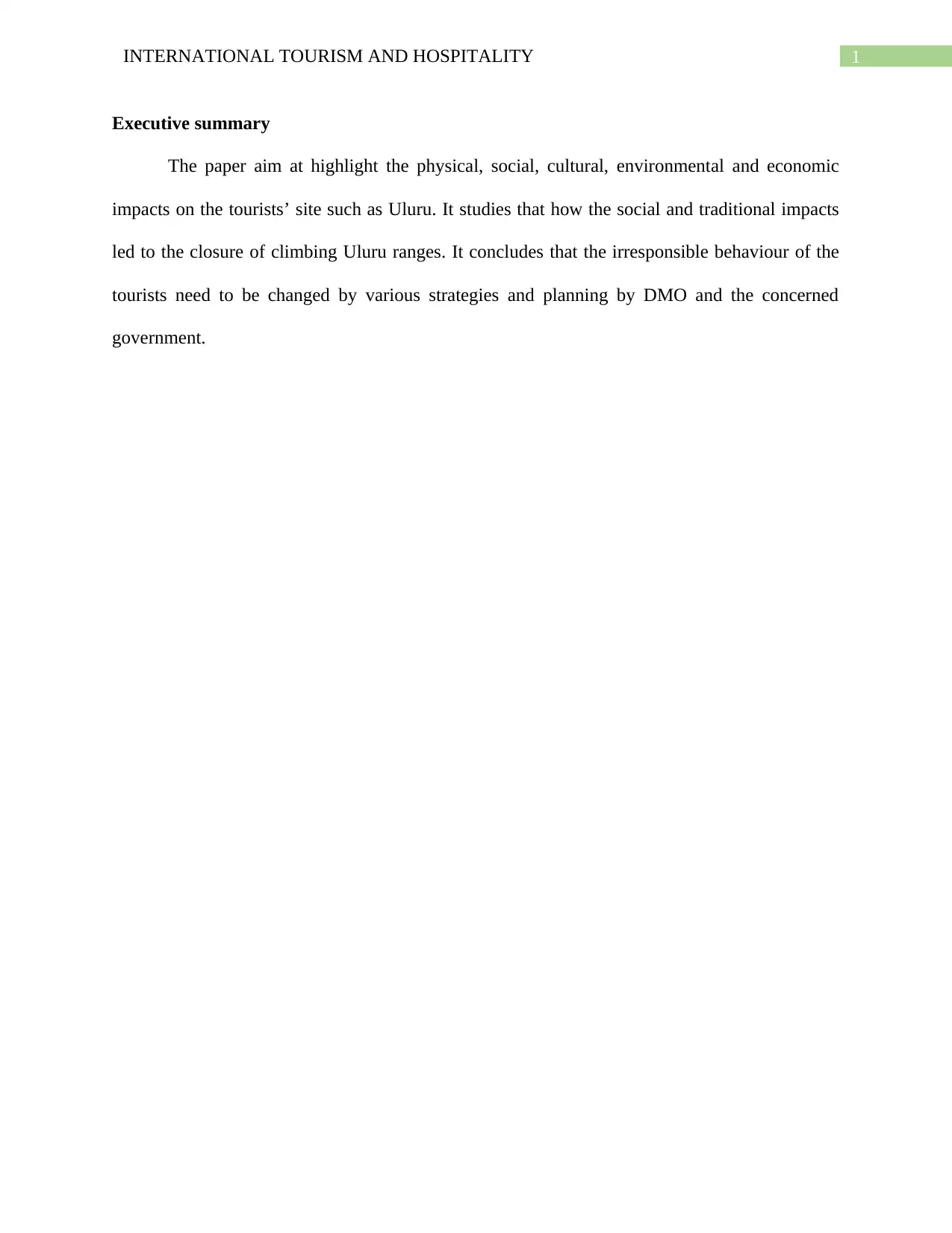
1INTERNATIONAL TOURISM AND HOSPITALITY
Executive summary
The paper aim at highlight the physical, social, cultural, environmental and economic
impacts on the tourists’ site such as Uluru. It studies that how the social and traditional impacts
led to the closure of climbing Uluru ranges. It concludes that the irresponsible behaviour of the
tourists need to be changed by various strategies and planning by DMO and the concerned
government.
Executive summary
The paper aim at highlight the physical, social, cultural, environmental and economic
impacts on the tourists’ site such as Uluru. It studies that how the social and traditional impacts
led to the closure of climbing Uluru ranges. It concludes that the irresponsible behaviour of the
tourists need to be changed by various strategies and planning by DMO and the concerned
government.
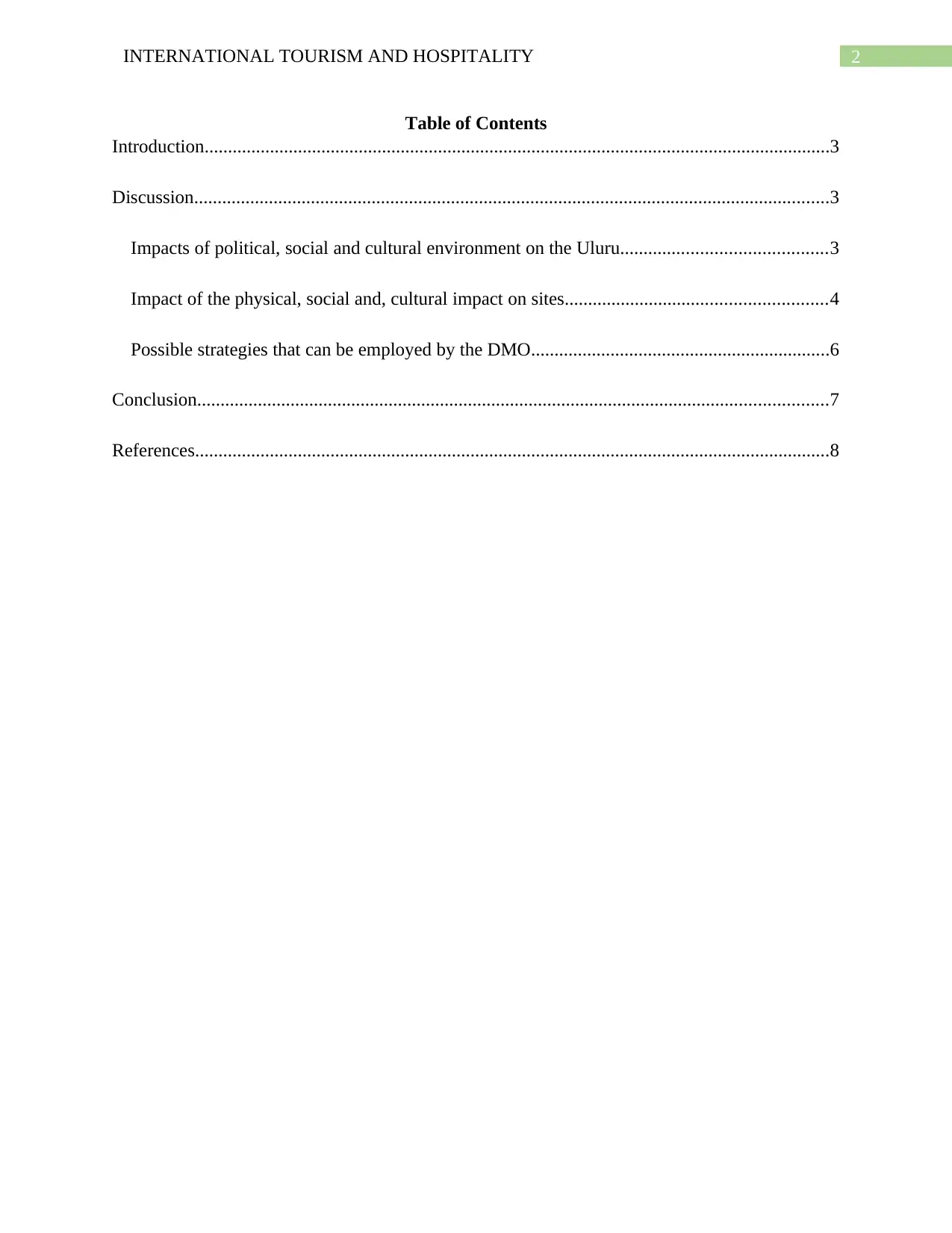
2INTERNATIONAL TOURISM AND HOSPITALITY
Table of Contents
Introduction......................................................................................................................................3
Discussion........................................................................................................................................3
Impacts of political, social and cultural environment on the Uluru............................................3
Impact of the physical, social and, cultural impact on sites........................................................4
Possible strategies that can be employed by the DMO................................................................6
Conclusion.......................................................................................................................................7
References........................................................................................................................................8
Table of Contents
Introduction......................................................................................................................................3
Discussion........................................................................................................................................3
Impacts of political, social and cultural environment on the Uluru............................................3
Impact of the physical, social and, cultural impact on sites........................................................4
Possible strategies that can be employed by the DMO................................................................6
Conclusion.......................................................................................................................................7
References........................................................................................................................................8
⊘ This is a preview!⊘
Do you want full access?
Subscribe today to unlock all pages.

Trusted by 1+ million students worldwide
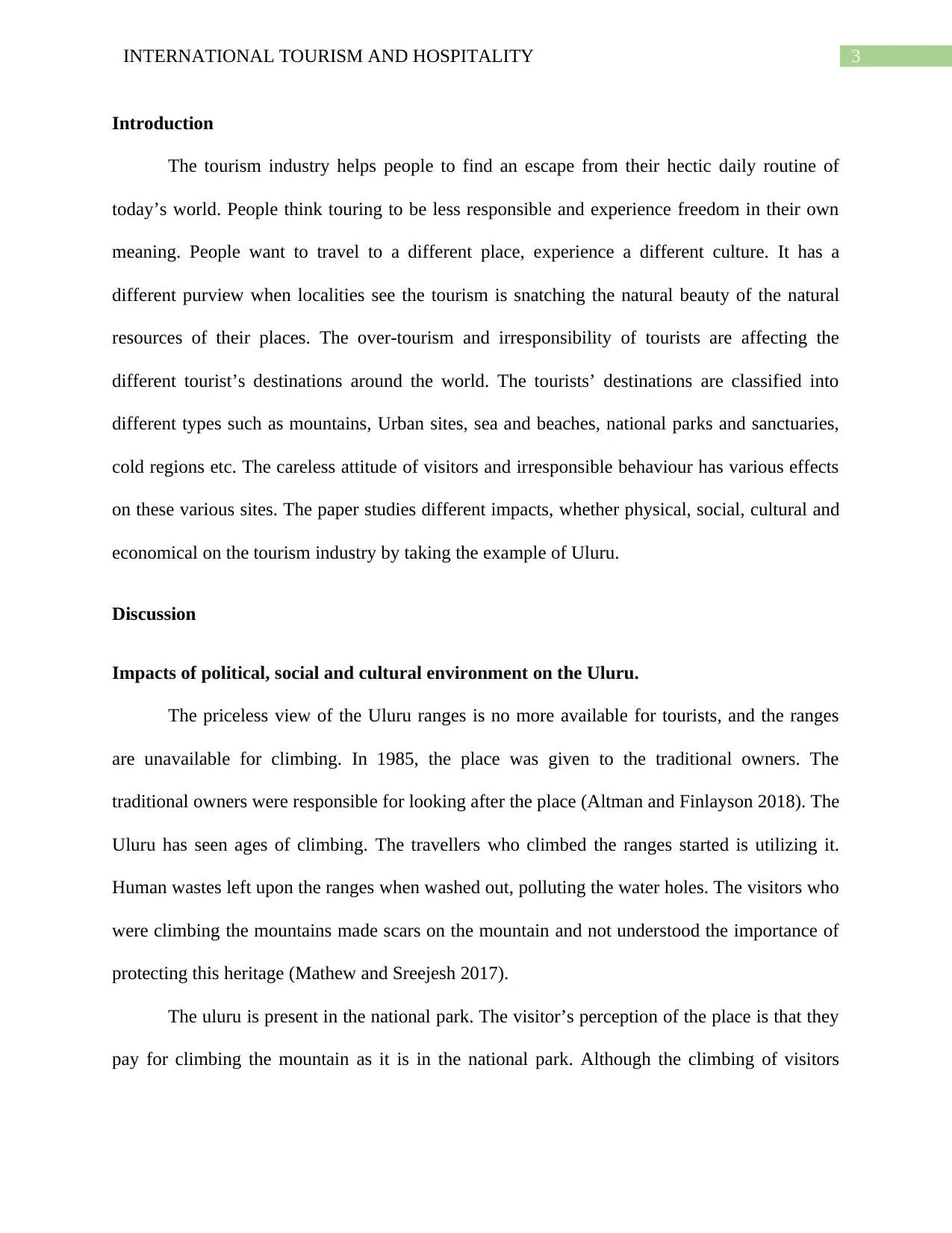
3INTERNATIONAL TOURISM AND HOSPITALITY
Introduction
The tourism industry helps people to find an escape from their hectic daily routine of
today’s world. People think touring to be less responsible and experience freedom in their own
meaning. People want to travel to a different place, experience a different culture. It has a
different purview when localities see the tourism is snatching the natural beauty of the natural
resources of their places. The over-tourism and irresponsibility of tourists are affecting the
different tourist’s destinations around the world. The tourists’ destinations are classified into
different types such as mountains, Urban sites, sea and beaches, national parks and sanctuaries,
cold regions etc. The careless attitude of visitors and irresponsible behaviour has various effects
on these various sites. The paper studies different impacts, whether physical, social, cultural and
economical on the tourism industry by taking the example of Uluru.
Discussion
Impacts of political, social and cultural environment on the Uluru.
The priceless view of the Uluru ranges is no more available for tourists, and the ranges
are unavailable for climbing. In 1985, the place was given to the traditional owners. The
traditional owners were responsible for looking after the place (Altman and Finlayson 2018). The
Uluru has seen ages of climbing. The travellers who climbed the ranges started is utilizing it.
Human wastes left upon the ranges when washed out, polluting the water holes. The visitors who
were climbing the mountains made scars on the mountain and not understood the importance of
protecting this heritage (Mathew and Sreejesh 2017).
The uluru is present in the national park. The visitor’s perception of the place is that they
pay for climbing the mountain as it is in the national park. Although the climbing of visitors
Introduction
The tourism industry helps people to find an escape from their hectic daily routine of
today’s world. People think touring to be less responsible and experience freedom in their own
meaning. People want to travel to a different place, experience a different culture. It has a
different purview when localities see the tourism is snatching the natural beauty of the natural
resources of their places. The over-tourism and irresponsibility of tourists are affecting the
different tourist’s destinations around the world. The tourists’ destinations are classified into
different types such as mountains, Urban sites, sea and beaches, national parks and sanctuaries,
cold regions etc. The careless attitude of visitors and irresponsible behaviour has various effects
on these various sites. The paper studies different impacts, whether physical, social, cultural and
economical on the tourism industry by taking the example of Uluru.
Discussion
Impacts of political, social and cultural environment on the Uluru.
The priceless view of the Uluru ranges is no more available for tourists, and the ranges
are unavailable for climbing. In 1985, the place was given to the traditional owners. The
traditional owners were responsible for looking after the place (Altman and Finlayson 2018). The
Uluru has seen ages of climbing. The travellers who climbed the ranges started is utilizing it.
Human wastes left upon the ranges when washed out, polluting the water holes. The visitors who
were climbing the mountains made scars on the mountain and not understood the importance of
protecting this heritage (Mathew and Sreejesh 2017).
The uluru is present in the national park. The visitor’s perception of the place is that they
pay for climbing the mountain as it is in the national park. Although the climbing of visitors
Paraphrase This Document
Need a fresh take? Get an instant paraphrase of this document with our AI Paraphraser
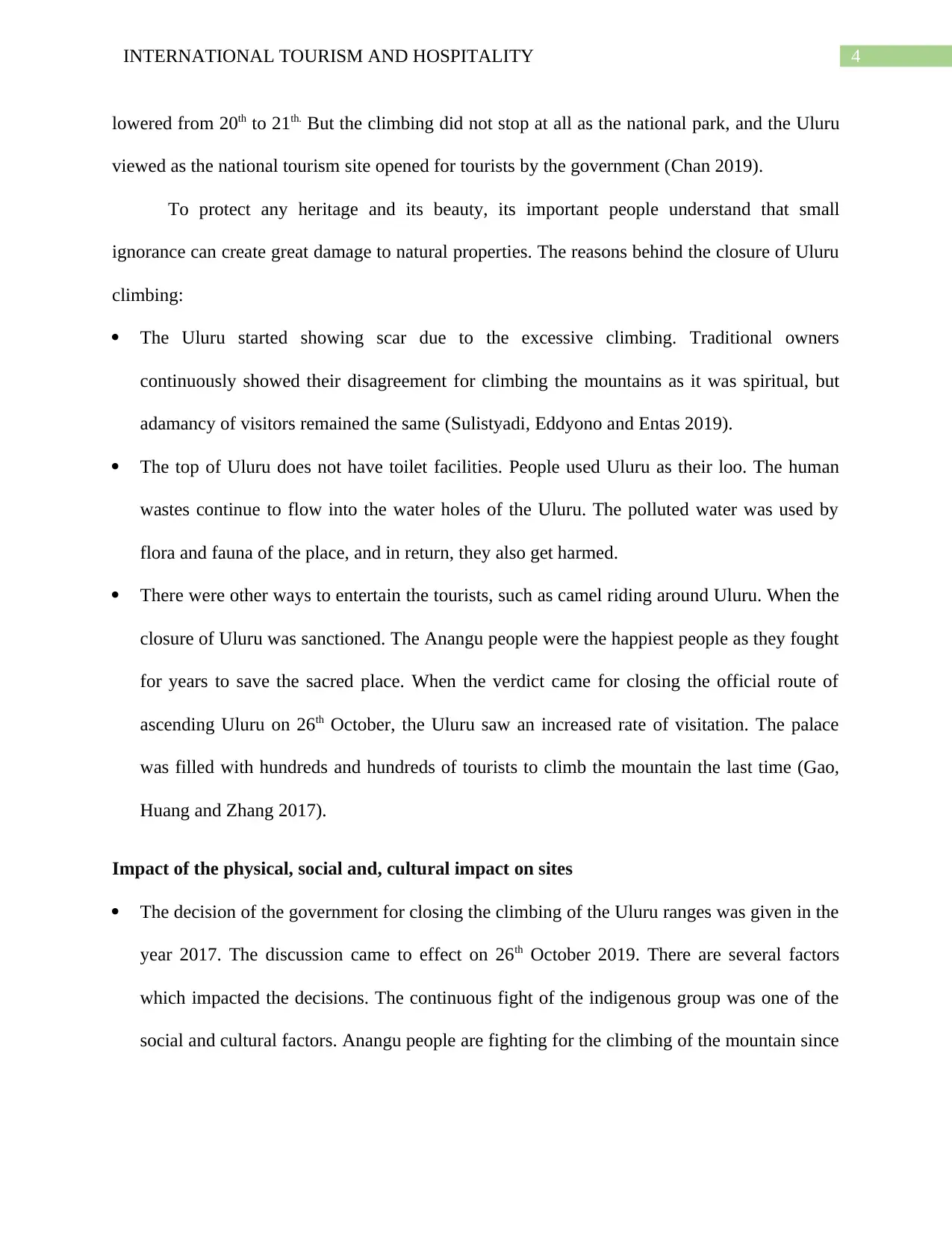
4INTERNATIONAL TOURISM AND HOSPITALITY
lowered from 20th to 21th. But the climbing did not stop at all as the national park, and the Uluru
viewed as the national tourism site opened for tourists by the government (Chan 2019).
To protect any heritage and its beauty, its important people understand that small
ignorance can create great damage to natural properties. The reasons behind the closure of Uluru
climbing:
The Uluru started showing scar due to the excessive climbing. Traditional owners
continuously showed their disagreement for climbing the mountains as it was spiritual, but
adamancy of visitors remained the same (Sulistyadi, Eddyono and Entas 2019).
The top of Uluru does not have toilet facilities. People used Uluru as their loo. The human
wastes continue to flow into the water holes of the Uluru. The polluted water was used by
flora and fauna of the place, and in return, they also get harmed.
There were other ways to entertain the tourists, such as camel riding around Uluru. When the
closure of Uluru was sanctioned. The Anangu people were the happiest people as they fought
for years to save the sacred place. When the verdict came for closing the official route of
ascending Uluru on 26th October, the Uluru saw an increased rate of visitation. The palace
was filled with hundreds and hundreds of tourists to climb the mountain the last time (Gao,
Huang and Zhang 2017).
Impact of the physical, social and, cultural impact on sites
The decision of the government for closing the climbing of the Uluru ranges was given in the
year 2017. The discussion came to effect on 26th October 2019. There are several factors
which impacted the decisions. The continuous fight of the indigenous group was one of the
social and cultural factors. Anangu people are fighting for the climbing of the mountain since
lowered from 20th to 21th. But the climbing did not stop at all as the national park, and the Uluru
viewed as the national tourism site opened for tourists by the government (Chan 2019).
To protect any heritage and its beauty, its important people understand that small
ignorance can create great damage to natural properties. The reasons behind the closure of Uluru
climbing:
The Uluru started showing scar due to the excessive climbing. Traditional owners
continuously showed their disagreement for climbing the mountains as it was spiritual, but
adamancy of visitors remained the same (Sulistyadi, Eddyono and Entas 2019).
The top of Uluru does not have toilet facilities. People used Uluru as their loo. The human
wastes continue to flow into the water holes of the Uluru. The polluted water was used by
flora and fauna of the place, and in return, they also get harmed.
There were other ways to entertain the tourists, such as camel riding around Uluru. When the
closure of Uluru was sanctioned. The Anangu people were the happiest people as they fought
for years to save the sacred place. When the verdict came for closing the official route of
ascending Uluru on 26th October, the Uluru saw an increased rate of visitation. The palace
was filled with hundreds and hundreds of tourists to climb the mountain the last time (Gao,
Huang and Zhang 2017).
Impact of the physical, social and, cultural impact on sites
The decision of the government for closing the climbing of the Uluru ranges was given in the
year 2017. The discussion came to effect on 26th October 2019. There are several factors
which impacted the decisions. The continuous fight of the indigenous group was one of the
social and cultural factors. Anangu people are fighting for the climbing of the mountain since
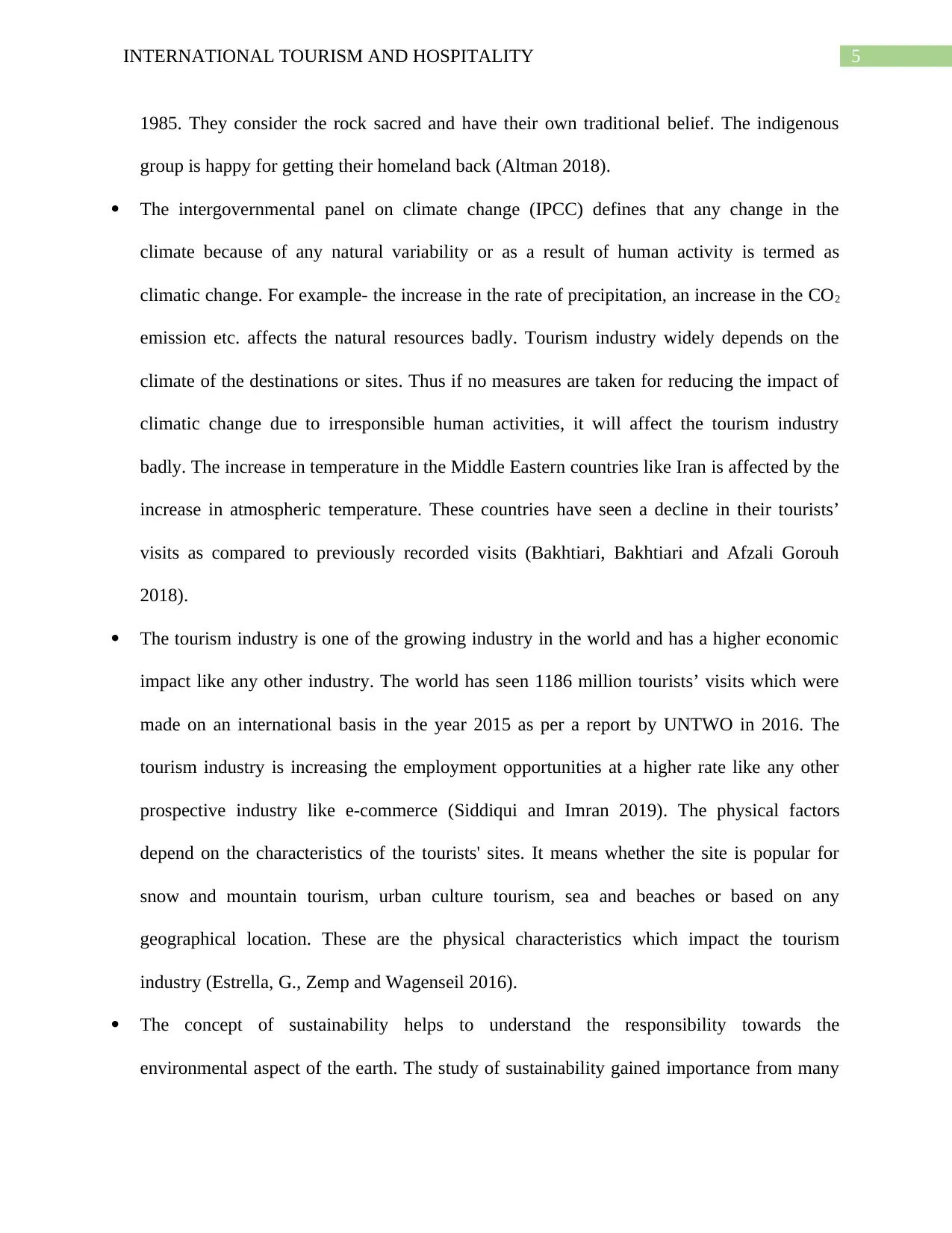
5INTERNATIONAL TOURISM AND HOSPITALITY
1985. They consider the rock sacred and have their own traditional belief. The indigenous
group is happy for getting their homeland back (Altman 2018).
The intergovernmental panel on climate change (IPCC) defines that any change in the
climate because of any natural variability or as a result of human activity is termed as
climatic change. For example- the increase in the rate of precipitation, an increase in the CO2
emission etc. affects the natural resources badly. Tourism industry widely depends on the
climate of the destinations or sites. Thus if no measures are taken for reducing the impact of
climatic change due to irresponsible human activities, it will affect the tourism industry
badly. The increase in temperature in the Middle Eastern countries like Iran is affected by the
increase in atmospheric temperature. These countries have seen a decline in their tourists’
visits as compared to previously recorded visits (Bakhtiari, Bakhtiari and Afzali Gorouh
2018).
The tourism industry is one of the growing industry in the world and has a higher economic
impact like any other industry. The world has seen 1186 million tourists’ visits which were
made on an international basis in the year 2015 as per a report by UNTWO in 2016. The
tourism industry is increasing the employment opportunities at a higher rate like any other
prospective industry like e-commerce (Siddiqui and Imran 2019). The physical factors
depend on the characteristics of the tourists' sites. It means whether the site is popular for
snow and mountain tourism, urban culture tourism, sea and beaches or based on any
geographical location. These are the physical characteristics which impact the tourism
industry (Estrella, G., Zemp and Wagenseil 2016).
The concept of sustainability helps to understand the responsibility towards the
environmental aspect of the earth. The study of sustainability gained importance from many
1985. They consider the rock sacred and have their own traditional belief. The indigenous
group is happy for getting their homeland back (Altman 2018).
The intergovernmental panel on climate change (IPCC) defines that any change in the
climate because of any natural variability or as a result of human activity is termed as
climatic change. For example- the increase in the rate of precipitation, an increase in the CO2
emission etc. affects the natural resources badly. Tourism industry widely depends on the
climate of the destinations or sites. Thus if no measures are taken for reducing the impact of
climatic change due to irresponsible human activities, it will affect the tourism industry
badly. The increase in temperature in the Middle Eastern countries like Iran is affected by the
increase in atmospheric temperature. These countries have seen a decline in their tourists’
visits as compared to previously recorded visits (Bakhtiari, Bakhtiari and Afzali Gorouh
2018).
The tourism industry is one of the growing industry in the world and has a higher economic
impact like any other industry. The world has seen 1186 million tourists’ visits which were
made on an international basis in the year 2015 as per a report by UNTWO in 2016. The
tourism industry is increasing the employment opportunities at a higher rate like any other
prospective industry like e-commerce (Siddiqui and Imran 2019). The physical factors
depend on the characteristics of the tourists' sites. It means whether the site is popular for
snow and mountain tourism, urban culture tourism, sea and beaches or based on any
geographical location. These are the physical characteristics which impact the tourism
industry (Estrella, G., Zemp and Wagenseil 2016).
The concept of sustainability helps to understand the responsibility towards the
environmental aspect of the earth. The study of sustainability gained importance from many
⊘ This is a preview!⊘
Do you want full access?
Subscribe today to unlock all pages.

Trusted by 1+ million students worldwide
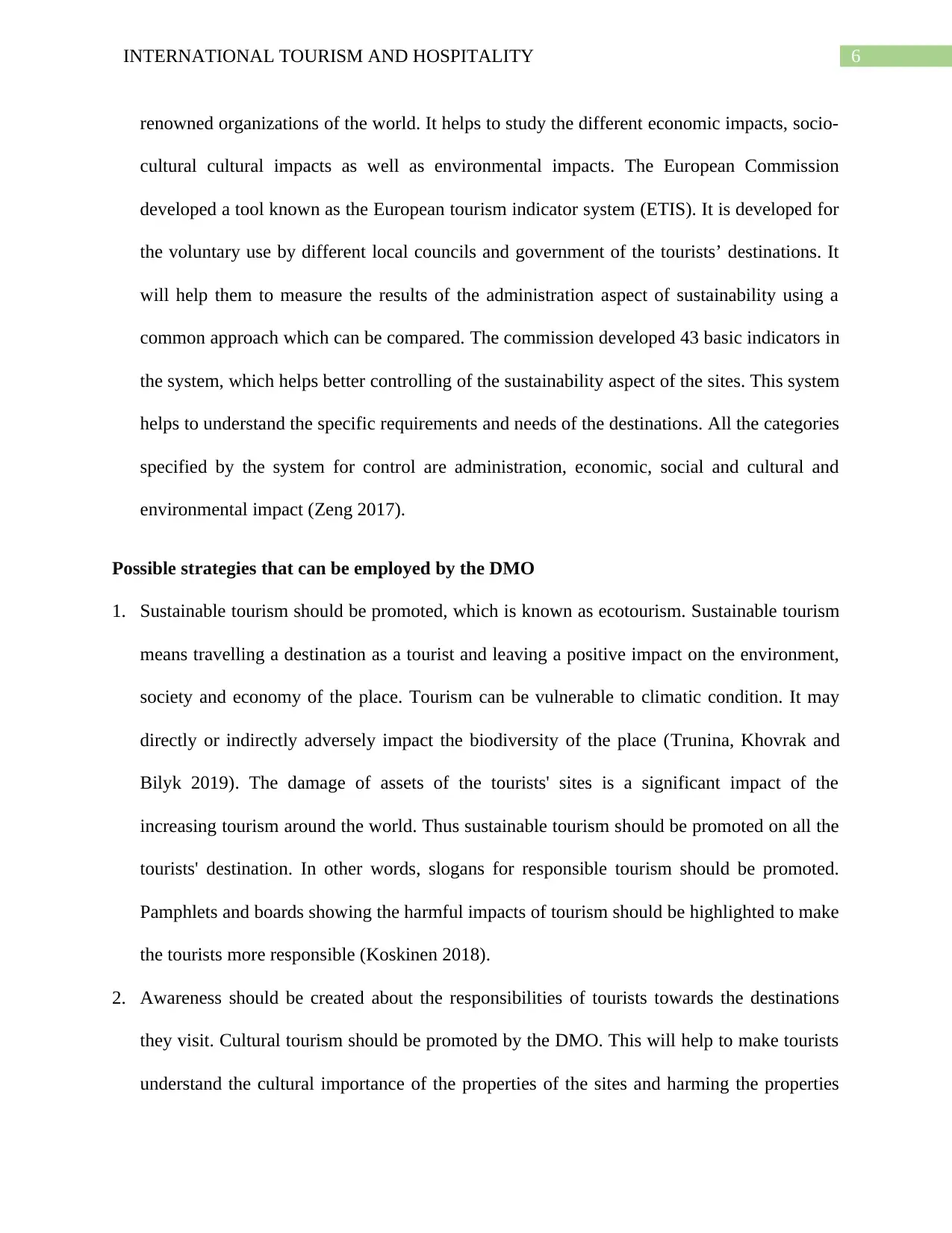
6INTERNATIONAL TOURISM AND HOSPITALITY
renowned organizations of the world. It helps to study the different economic impacts, socio-
cultural cultural impacts as well as environmental impacts. The European Commission
developed a tool known as the European tourism indicator system (ETIS). It is developed for
the voluntary use by different local councils and government of the tourists’ destinations. It
will help them to measure the results of the administration aspect of sustainability using a
common approach which can be compared. The commission developed 43 basic indicators in
the system, which helps better controlling of the sustainability aspect of the sites. This system
helps to understand the specific requirements and needs of the destinations. All the categories
specified by the system for control are administration, economic, social and cultural and
environmental impact (Zeng 2017).
Possible strategies that can be employed by the DMO
1. Sustainable tourism should be promoted, which is known as ecotourism. Sustainable tourism
means travelling a destination as a tourist and leaving a positive impact on the environment,
society and economy of the place. Tourism can be vulnerable to climatic condition. It may
directly or indirectly adversely impact the biodiversity of the place (Trunina, Khovrak and
Bilyk 2019). The damage of assets of the tourists' sites is a significant impact of the
increasing tourism around the world. Thus sustainable tourism should be promoted on all the
tourists' destination. In other words, slogans for responsible tourism should be promoted.
Pamphlets and boards showing the harmful impacts of tourism should be highlighted to make
the tourists more responsible (Koskinen 2018).
2. Awareness should be created about the responsibilities of tourists towards the destinations
they visit. Cultural tourism should be promoted by the DMO. This will help to make tourists
understand the cultural importance of the properties of the sites and harming the properties
renowned organizations of the world. It helps to study the different economic impacts, socio-
cultural cultural impacts as well as environmental impacts. The European Commission
developed a tool known as the European tourism indicator system (ETIS). It is developed for
the voluntary use by different local councils and government of the tourists’ destinations. It
will help them to measure the results of the administration aspect of sustainability using a
common approach which can be compared. The commission developed 43 basic indicators in
the system, which helps better controlling of the sustainability aspect of the sites. This system
helps to understand the specific requirements and needs of the destinations. All the categories
specified by the system for control are administration, economic, social and cultural and
environmental impact (Zeng 2017).
Possible strategies that can be employed by the DMO
1. Sustainable tourism should be promoted, which is known as ecotourism. Sustainable tourism
means travelling a destination as a tourist and leaving a positive impact on the environment,
society and economy of the place. Tourism can be vulnerable to climatic condition. It may
directly or indirectly adversely impact the biodiversity of the place (Trunina, Khovrak and
Bilyk 2019). The damage of assets of the tourists' sites is a significant impact of the
increasing tourism around the world. Thus sustainable tourism should be promoted on all the
tourists' destination. In other words, slogans for responsible tourism should be promoted.
Pamphlets and boards showing the harmful impacts of tourism should be highlighted to make
the tourists more responsible (Koskinen 2018).
2. Awareness should be created about the responsibilities of tourists towards the destinations
they visit. Cultural tourism should be promoted by the DMO. This will help to make tourists
understand the cultural importance of the properties of the sites and harming the properties
Paraphrase This Document
Need a fresh take? Get an instant paraphrase of this document with our AI Paraphraser

7INTERNATIONAL TOURISM AND HOSPITALITY
and beauty of these sites means destroying the culture of the place as happened in Uluru. The
sacred importance of the mountains ignored, and people treated the place irresponsibly
(Yoon et al. 2019).
3. Adventure activities can be promoted and financed by the local councils so that people can
be entertained by engaging themselves in these adventurous activities and do limit their
activities which can hamper the natural resources of the place. The people will be motivated
to these activities and enjoy their visits rather destroying the beauty of the sites.
4. The people from local communities can be employed as the protector and guide of the sites.
They should be made responsible for conveying the importance of natural properties by
telling ancient stories. They will be telling the dos and don’t to the tourists for protecting the
sites. The effective and friendly communication with the local people will help the tourists
understand the cocial and cultural value of the sites opened for tourism.
5. Sustainable partnerships with the hotel, eco-tours, sustainable transportation providers etc.
can help the DMO in protecting the tourist’s sites from ill practices. These partners can
promote the importance of protecting the natural resources of the destination and also
promote the sustainable use of it (Estrella, Zemp and Wagenseil 2016).
6. The organization should try to combat over-tourism, which can impact the destinations badly.
The marketing strategy should be planned accordingly to promote sustainable use and travel
in the place (Arbogast, Deng and Maumbe 2017).
Conclusion
Thus it is concluded that the tourism industry needs lots of attention of the public organizations
and the sustainable organizations which can come forward to protect the natural resources which
are becoming just the centre of economic benefit. These sites have a lot more than the economic
and beauty of these sites means destroying the culture of the place as happened in Uluru. The
sacred importance of the mountains ignored, and people treated the place irresponsibly
(Yoon et al. 2019).
3. Adventure activities can be promoted and financed by the local councils so that people can
be entertained by engaging themselves in these adventurous activities and do limit their
activities which can hamper the natural resources of the place. The people will be motivated
to these activities and enjoy their visits rather destroying the beauty of the sites.
4. The people from local communities can be employed as the protector and guide of the sites.
They should be made responsible for conveying the importance of natural properties by
telling ancient stories. They will be telling the dos and don’t to the tourists for protecting the
sites. The effective and friendly communication with the local people will help the tourists
understand the cocial and cultural value of the sites opened for tourism.
5. Sustainable partnerships with the hotel, eco-tours, sustainable transportation providers etc.
can help the DMO in protecting the tourist’s sites from ill practices. These partners can
promote the importance of protecting the natural resources of the destination and also
promote the sustainable use of it (Estrella, Zemp and Wagenseil 2016).
6. The organization should try to combat over-tourism, which can impact the destinations badly.
The marketing strategy should be planned accordingly to promote sustainable use and travel
in the place (Arbogast, Deng and Maumbe 2017).
Conclusion
Thus it is concluded that the tourism industry needs lots of attention of the public organizations
and the sustainable organizations which can come forward to protect the natural resources which
are becoming just the centre of economic benefit. These sites have a lot more than the economic
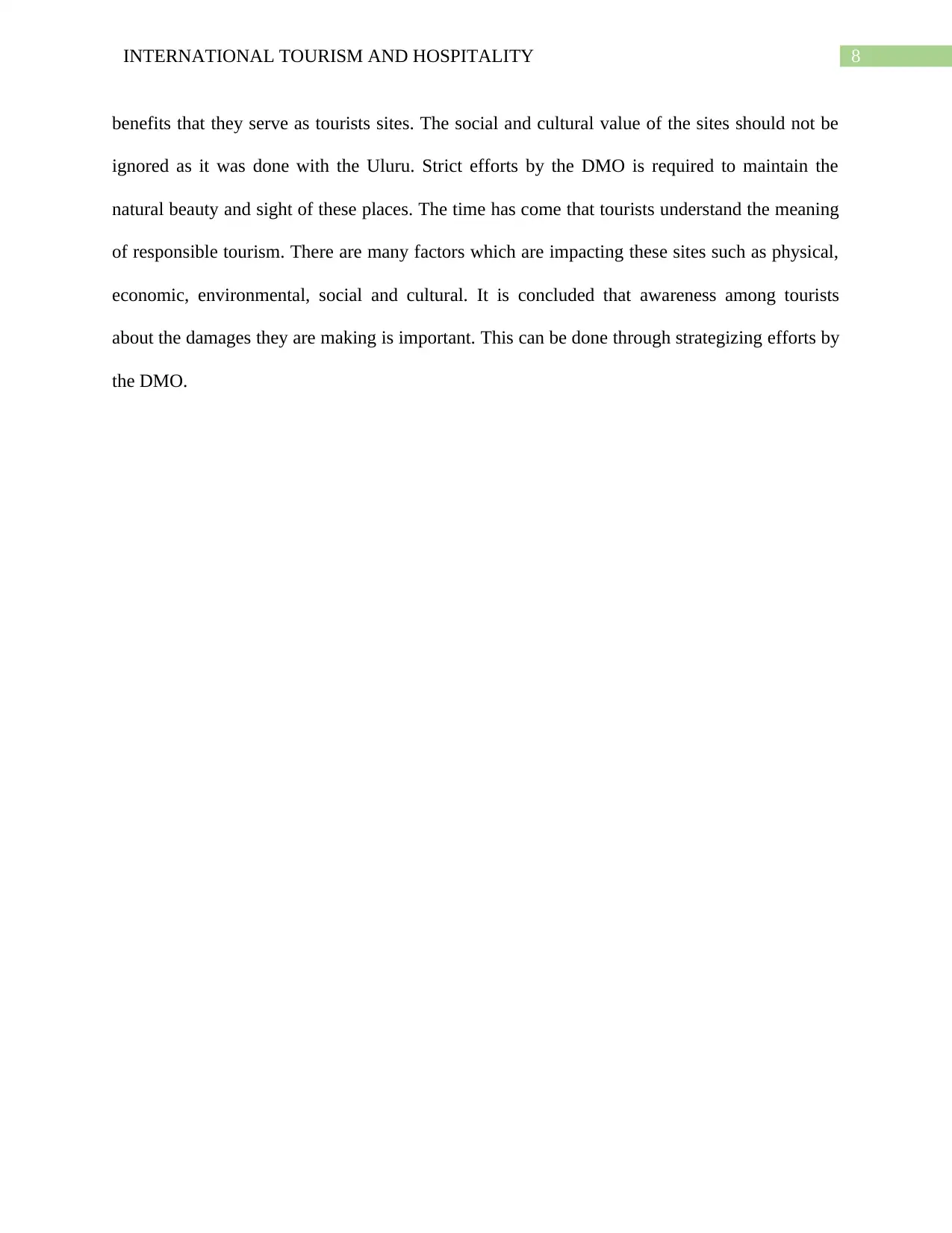
8INTERNATIONAL TOURISM AND HOSPITALITY
benefits that they serve as tourists sites. The social and cultural value of the sites should not be
ignored as it was done with the Uluru. Strict efforts by the DMO is required to maintain the
natural beauty and sight of these places. The time has come that tourists understand the meaning
of responsible tourism. There are many factors which are impacting these sites such as physical,
economic, environmental, social and cultural. It is concluded that awareness among tourists
about the damages they are making is important. This can be done through strategizing efforts by
the DMO.
benefits that they serve as tourists sites. The social and cultural value of the sites should not be
ignored as it was done with the Uluru. Strict efforts by the DMO is required to maintain the
natural beauty and sight of these places. The time has come that tourists understand the meaning
of responsible tourism. There are many factors which are impacting these sites such as physical,
economic, environmental, social and cultural. It is concluded that awareness among tourists
about the damages they are making is important. This can be done through strategizing efforts by
the DMO.
⊘ This is a preview!⊘
Do you want full access?
Subscribe today to unlock all pages.

Trusted by 1+ million students worldwide
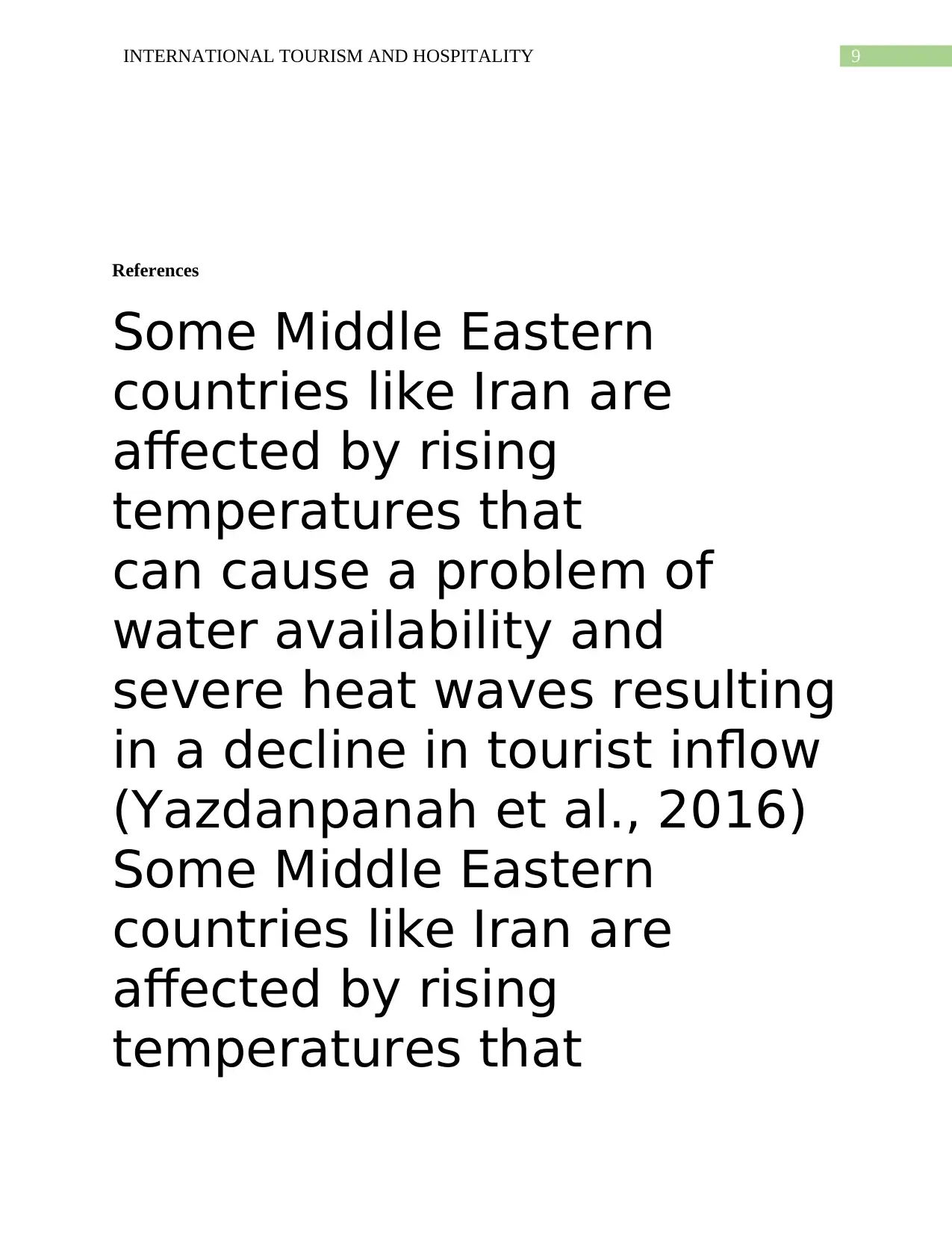
9INTERNATIONAL TOURISM AND HOSPITALITY
References
Some Middle Eastern
countries like Iran are
affected by rising
temperatures that
can cause a problem of
water availability and
severe heat waves resulting
in a decline in tourist inflow
(Yazdanpanah et al., 2016)
Some Middle Eastern
countries like Iran are
affected by rising
temperatures that
References
Some Middle Eastern
countries like Iran are
affected by rising
temperatures that
can cause a problem of
water availability and
severe heat waves resulting
in a decline in tourist inflow
(Yazdanpanah et al., 2016)
Some Middle Eastern
countries like Iran are
affected by rising
temperatures that
Paraphrase This Document
Need a fresh take? Get an instant paraphrase of this document with our AI Paraphraser
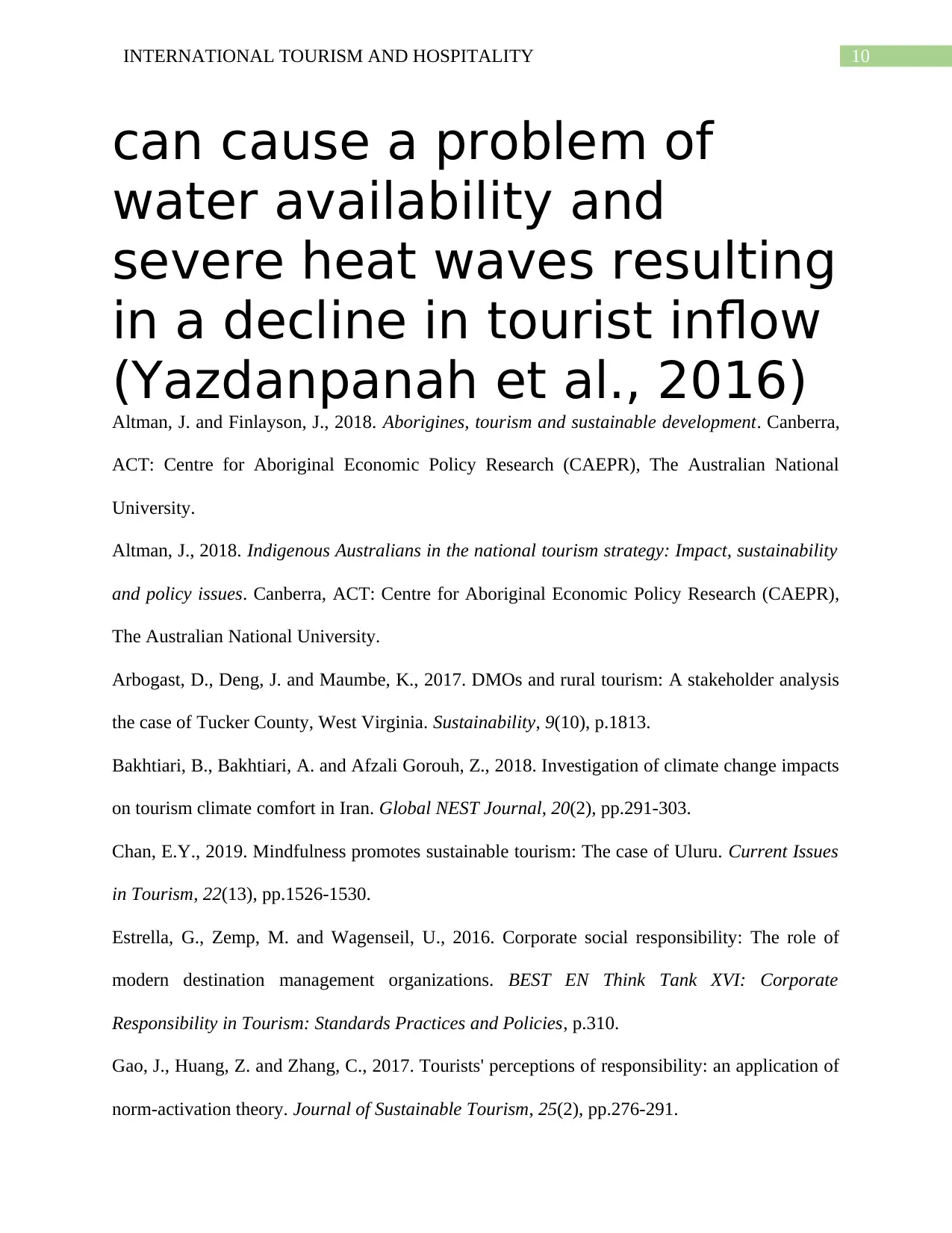
10INTERNATIONAL TOURISM AND HOSPITALITY
can cause a problem of
water availability and
severe heat waves resulting
in a decline in tourist inflow
(Yazdanpanah et al., 2016)
Altman, J. and Finlayson, J., 2018. Aborigines, tourism and sustainable development. Canberra,
ACT: Centre for Aboriginal Economic Policy Research (CAEPR), The Australian National
University.
Altman, J., 2018. Indigenous Australians in the national tourism strategy: Impact, sustainability
and policy issues. Canberra, ACT: Centre for Aboriginal Economic Policy Research (CAEPR),
The Australian National University.
Arbogast, D., Deng, J. and Maumbe, K., 2017. DMOs and rural tourism: A stakeholder analysis
the case of Tucker County, West Virginia. Sustainability, 9(10), p.1813.
Bakhtiari, B., Bakhtiari, A. and Afzali Gorouh, Z., 2018. Investigation of climate change impacts
on tourism climate comfort in Iran. Global NEST Journal, 20(2), pp.291-303.
Chan, E.Y., 2019. Mindfulness promotes sustainable tourism: The case of Uluru. Current Issues
in Tourism, 22(13), pp.1526-1530.
Estrella, G., Zemp, M. and Wagenseil, U., 2016. Corporate social responsibility: The role of
modern destination management organizations. BEST EN Think Tank XVI: Corporate
Responsibility in Tourism: Standards Practices and Policies, p.310.
Gao, J., Huang, Z. and Zhang, C., 2017. Tourists' perceptions of responsibility: an application of
norm-activation theory. Journal of Sustainable Tourism, 25(2), pp.276-291.
can cause a problem of
water availability and
severe heat waves resulting
in a decline in tourist inflow
(Yazdanpanah et al., 2016)
Altman, J. and Finlayson, J., 2018. Aborigines, tourism and sustainable development. Canberra,
ACT: Centre for Aboriginal Economic Policy Research (CAEPR), The Australian National
University.
Altman, J., 2018. Indigenous Australians in the national tourism strategy: Impact, sustainability
and policy issues. Canberra, ACT: Centre for Aboriginal Economic Policy Research (CAEPR),
The Australian National University.
Arbogast, D., Deng, J. and Maumbe, K., 2017. DMOs and rural tourism: A stakeholder analysis
the case of Tucker County, West Virginia. Sustainability, 9(10), p.1813.
Bakhtiari, B., Bakhtiari, A. and Afzali Gorouh, Z., 2018. Investigation of climate change impacts
on tourism climate comfort in Iran. Global NEST Journal, 20(2), pp.291-303.
Chan, E.Y., 2019. Mindfulness promotes sustainable tourism: The case of Uluru. Current Issues
in Tourism, 22(13), pp.1526-1530.
Estrella, G., Zemp, M. and Wagenseil, U., 2016. Corporate social responsibility: The role of
modern destination management organizations. BEST EN Think Tank XVI: Corporate
Responsibility in Tourism: Standards Practices and Policies, p.310.
Gao, J., Huang, Z. and Zhang, C., 2017. Tourists' perceptions of responsibility: an application of
norm-activation theory. Journal of Sustainable Tourism, 25(2), pp.276-291.
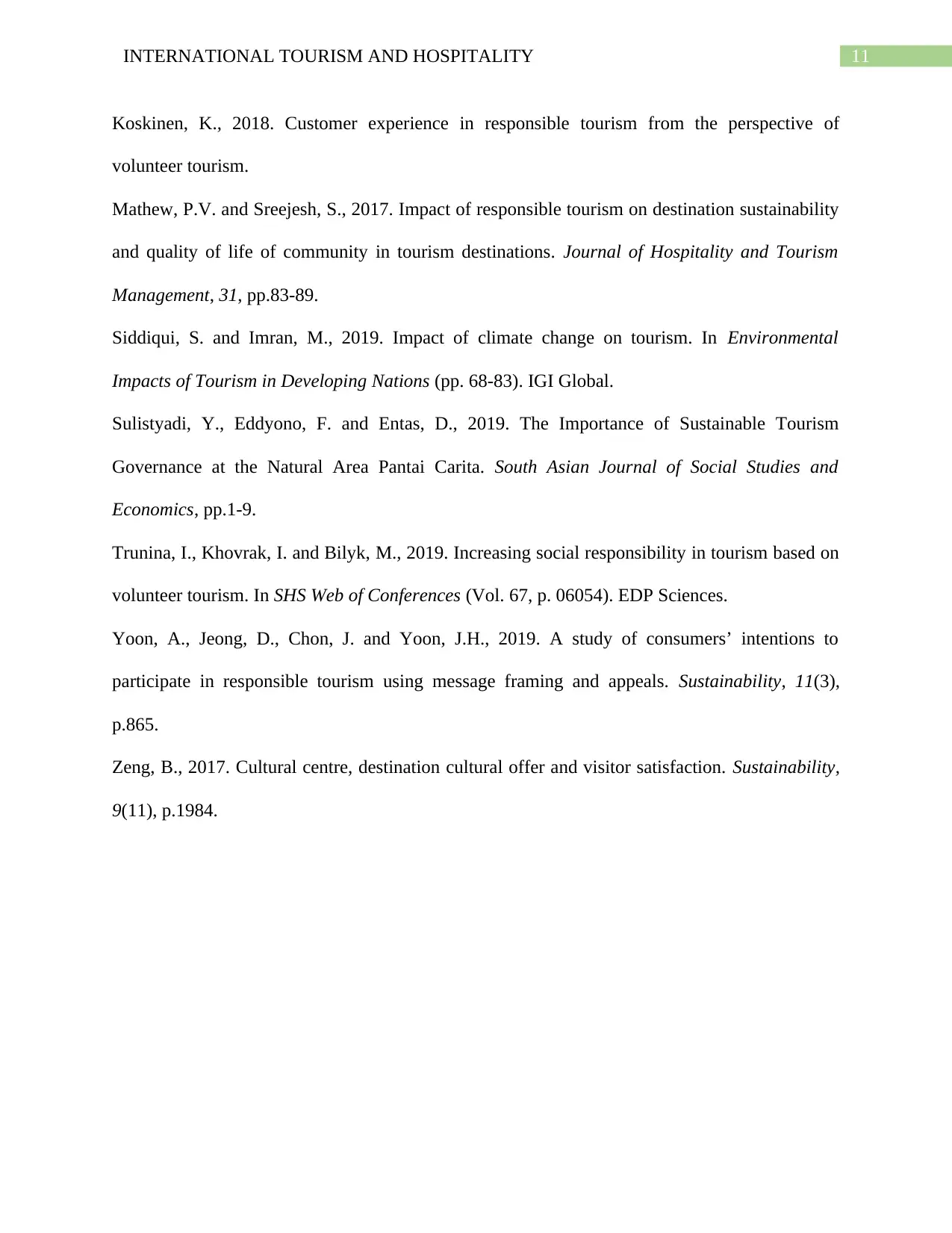
11INTERNATIONAL TOURISM AND HOSPITALITY
Koskinen, K., 2018. Customer experience in responsible tourism from the perspective of
volunteer tourism.
Mathew, P.V. and Sreejesh, S., 2017. Impact of responsible tourism on destination sustainability
and quality of life of community in tourism destinations. Journal of Hospitality and Tourism
Management, 31, pp.83-89.
Siddiqui, S. and Imran, M., 2019. Impact of climate change on tourism. In Environmental
Impacts of Tourism in Developing Nations (pp. 68-83). IGI Global.
Sulistyadi, Y., Eddyono, F. and Entas, D., 2019. The Importance of Sustainable Tourism
Governance at the Natural Area Pantai Carita. South Asian Journal of Social Studies and
Economics, pp.1-9.
Trunina, I., Khovrak, I. and Bilyk, M., 2019. Increasing social responsibility in tourism based on
volunteer tourism. In SHS Web of Conferences (Vol. 67, p. 06054). EDP Sciences.
Yoon, A., Jeong, D., Chon, J. and Yoon, J.H., 2019. A study of consumers’ intentions to
participate in responsible tourism using message framing and appeals. Sustainability, 11(3),
p.865.
Zeng, B., 2017. Cultural centre, destination cultural offer and visitor satisfaction. Sustainability,
9(11), p.1984.
Koskinen, K., 2018. Customer experience in responsible tourism from the perspective of
volunteer tourism.
Mathew, P.V. and Sreejesh, S., 2017. Impact of responsible tourism on destination sustainability
and quality of life of community in tourism destinations. Journal of Hospitality and Tourism
Management, 31, pp.83-89.
Siddiqui, S. and Imran, M., 2019. Impact of climate change on tourism. In Environmental
Impacts of Tourism in Developing Nations (pp. 68-83). IGI Global.
Sulistyadi, Y., Eddyono, F. and Entas, D., 2019. The Importance of Sustainable Tourism
Governance at the Natural Area Pantai Carita. South Asian Journal of Social Studies and
Economics, pp.1-9.
Trunina, I., Khovrak, I. and Bilyk, M., 2019. Increasing social responsibility in tourism based on
volunteer tourism. In SHS Web of Conferences (Vol. 67, p. 06054). EDP Sciences.
Yoon, A., Jeong, D., Chon, J. and Yoon, J.H., 2019. A study of consumers’ intentions to
participate in responsible tourism using message framing and appeals. Sustainability, 11(3),
p.865.
Zeng, B., 2017. Cultural centre, destination cultural offer and visitor satisfaction. Sustainability,
9(11), p.1984.
⊘ This is a preview!⊘
Do you want full access?
Subscribe today to unlock all pages.

Trusted by 1+ million students worldwide
1 out of 12
Related Documents
Your All-in-One AI-Powered Toolkit for Academic Success.
+13062052269
info@desklib.com
Available 24*7 on WhatsApp / Email
![[object Object]](/_next/static/media/star-bottom.7253800d.svg)
Unlock your academic potential
Copyright © 2020–2025 A2Z Services. All Rights Reserved. Developed and managed by ZUCOL.





